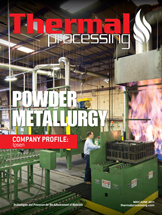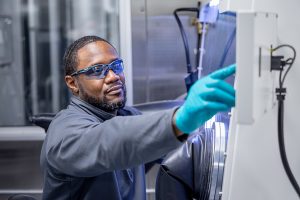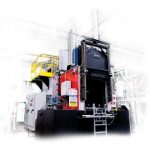For automobiles where competing hardening processes and materials are involved, automotive designers and heat treaters have choices when deciding how to meet efficiency standards.
There are only two methodologies for reducing the weight of an automobile: Reduce the overall size of the unit, or adopt less dense (lighter) materials for construction. Auto manufacturers in Europe and the U.S. each face their own challenges because consumers, for many reasons, desire different car models that affect the size and utility of the product offerings. The bottom-line criteria are not just to manufacture vehicles that meet the government standards but also produce vehicles that consumers will actually purchase.
The VW Golf has been and continues to be the leading vehicle sold in the EU in 2016. In the U.S., SUVs and crossovers have been the segment leader — 6,480,325 cars of all sizes were sold in 2016 in the U.S. compared to sales volumes of 9,379,597 light trucks (which includes all sizes of SUVs). Considering that SUVs and light trucks on average weigh more than passenger cars, they will require a higher proportion of weight reduction on average to meet their respective efficiency criteria.
Best-selling cars in Europe in 2016:
- VW Golf: 491,681 (most models sold)
- Renault (Clio): 310,944 (most models sold)
- VW Polo: 307,462 (most models sold)
- Ford Fiesta: 298,999 (most models sold)
Best-selling vehicles in the U.S. in 2016:
- Ford F-Series: 820,799 (½ ton pickup truck)
- Chevrolet Silverado: 574,876 (½ ton pickup truck)
- RAM Trucks: 489,418 (½ ton pickup truck)
- Toyota Camry: 388,616
- Honda Civic: 366,927
- Toyota Corolla: 360,483
- Honda CR-V: 357,335 (SUV crossover)
- Toyota RAV4: 352,139 (SUV crossover)
Meeting the 2025 CAFE standards in the U.S. certainly will be a challenge due to the weight of the vehicles; Americans love their trucks. With just eight years until 2025, improving the mileage by weight reduction alone seems undoable; therefore, a new generation of engines, transmissions, and hybrid technology likely will have to play a major role. However, EV and hybrid vehicles have yet to impress the American consumer.
Attempts at reducing fuel consumption have been adopted over the decades including decreasing the number of cylinders to reduce engine block mass. Probably the most significant and successful solution to date — and probably the most cost-effective one — has been the integration of turbochargers to four- and six-cylinder gasoline and diesel engines combined with six-, seven-, eight-, or even nine- and 10-speed transmissions. That approach also has limits, especially as the economy standards are applied to larger passenger vehicles and half-ton pickup trucks.
Where light trucks are concerned, one OEM has substituted aluminum for steel body panels, and a weight savings of 500 to 700 pounds (227 to 318 kilograms) has been reported. However, body panels are just one component subject to potential weight reduction. There are many other items that would be candidates for weight reduction such as suspension parts, transmission and transfer cases, structural, and space-frame components. Some will be fabrications; others will be castings and still others, forgings. In every case, the tradeoff between mass and strength will have to be considered as well as their potential for reducing post-heat-treat processing.
There are six materials with suitable strength-to-weight ratios used in automotive construction today:
- Magnesium
- Carbon composites
- Cast (gray iron)
- Aluminum
- Steel
- Austempered ductile iron (ADI)
Each of these materials is used for a specific performance characteristic. The advantages of these include the following:
Magnesium has slowly gained acceptance in automotive applications. Its low density and machinability makes it an ideal candidate for transmission, differential, and transfer cases. However, it lacks aluminum’s overall strength, making it unsuitable for engine blocks and similarly stressed applications. It also requires a protective coating to reduce corrosion, whereas aluminum has good oxidation resistance. Probably the biggest advantage of magnesium is its availability, although it is expensive to refine. It is not found in a pure state, but it can be refined from several materials such as dolomite, magnesite ore, and sea water and salt brines, which contain about 10 percent magnesium chloride. Ocean water alone contains about 0.13 percent magnesium [1].
Carbon fiber reinforced polymer (CFRP) has one of the most advantageous strength-to-weight ratios of any engineered material; however, it is not as easily recycled as aluminum and wrought and cast ferrous alloys. Much effort is being expended to make recycling more cost-effective. Most of the virgin woven poly fiber is produced in Japan and is used for aerospace applications as well as expensive automobiles. The aerospace industry produces about 35 percent CFRP scrap used in many under-hood automotive applications. The chopped recycled fiber material does not have the structural strength offered by virgin long fiber polymers for chassis or body panel applications [2]. Although heat is used to manufacture the raw carbon fiber, it does not play a significant role in making the final product.
One of the major obstacles facing CFRP is the end-of-life products stated in ELV Directive 2000/53/EC. This directive issued a 2015 target applicable to Europe and Japan that 95 percent of an automobile ready for the scrapyard must be recoverable and recyclable. Today, it is accepted that approximately 75 percent of an automobile is made from ferrous and non-ferrous metals, and the remaining 25 percent is toxic materials.
Gray cast iron has been the material for automobile engine blocks for decades, primarily because of its low cost and adequate strength for gasoline, but not for diesel, engines. Due to its lack of as-cast strength and the fact it is not normally hardened by heat treatment, it has limited application for stressed components. As for heat treatment, gray iron is rarely heat-treated to increase hardness, but it does receive treatment such as annealing or normalizing to enhance machinability. Stress relieving after welding is also common.
Examples of cast gray iron automotive components include:
- Engine blocks
- Brake rotors
- Constant velocity joint housings
- Exhaust manifolds
- Transmission cases
- Cylinder heads
Aluminum is more expensive to manufacture than steel, but it has an attractive strength-to-weight ratio and therefore has continued to see more application in automobiles and trucks. Much of it is recycled, and it requires different forming and coating techniques. Series 2000, 6000, and 7000 grades are hardenable by solution treating, rapid water quench, and either natural or artificial (heat) aging. As such, Series 6000 is finding application in structural and body panels of vehicles. A less tangible effect of material selection is sound conduction — a material may possess the ideal properties but transmit undesirable sound and vibration to the passenger cabin.
Steel and its alloys enjoy the highest percentage of application in cars and trucks, simply because of their wide range of strength-to-weight relationship through diverse heat-treating options. HSLA (high-strength low-alloy) grades have been used for years in substructures of cars and trucks in the U.S. The more recent use of higher hardenability alloy steel has been directed to drivetrain components such as transmission and differential gears where the goal is to reduce gear mass resulting in the growth seen with HPGQ (high-pressure gas-quench) and improved distortion control. HPGQ has seen its primary growth due to increased distortion control required for the more precise and less massive gearing for multi-speed transmissions. In addition, OEMs have realized that improving the hardenability, even at increased cost, may reduce or eliminate post-heat-treat machining/grinding/straightening in the end. One of the original drivers of the growth of HPGQ was the use and recovery of helium. However, as the capital cost and maintenance of compressors have increased, nitrogen is being used again. Nitrogen forces the user to improve the hardenability of steels since the horsepower for the fan motors to equal the quench capacity of helium would have to be increased to impractical levels.
DI (ductile iron) — specifically ADI (austempered ductile iron) — has been around for decades, but it has never seemed to gain mainstream acceptance compared to steel or aluminum. In my view, one of the reasons for this has been the negative perception of heat treating in salt. However, the salts used today are much more U.S. EPA-friendly than those used in the past for carburizing and cyaniding. Austempering salts comprise a 50/50 mixture of sodium nitrite and potassium nitrate compounds. A significant quantity is recycled by recovering salts from post-wash solutions. Similar to steel, alloying elements play a significant role in ADI to produce properties that will either increase hot strength or improve tensile strength and hardness. The major advantages of ADI is its lower density, strength-to-weight ratio, and toughness with wear resistance, plus it predictably has half the distortion of martensite.
Examples of cast ADI automotive components include:
- Turbo charger housings
- Suspension and steering components
- Constant velocity joint housings
- Exhaust manifolds
- Ring and pinions
Conclusion
There are several weight-reduction options regarding material and processes available to designers and heat treaters for automotive applications. However, the challenges are two-fold:
- Can the weight reduction choice be cost-effective in vehicle pricing?
- Can the selected process be integrated cost effectively into the predictive process automation (PPA) methodology of the manufacturer?
From a heat-treating viewpoint, controlling distortion in drivetrain components is a primary goal in reducing manufacturing cost. Since steel and ductile iron have the greatest potential for choosing an appropriate strength and wear-resistance parameter, austempering with its predictable and uniform growth seems poised to satisfy a number of weight-related obstacles. The one remaining issue facing austempering, the “Holy Grail of bainite,” is hardness. Additional research in micro-alloying ADI and steel would solve that major hurdle.
References
- “How Is Magnesium Metal Produced?” Commodities: by Terence Bell, Updated August 14, 2016.
- Composites World, Recycled carbon fiber update: Closing the CFRP lifecycle loop, Ginger Gardiner, article: 11/30/14
































